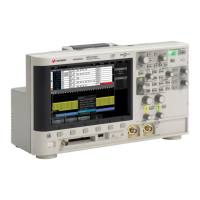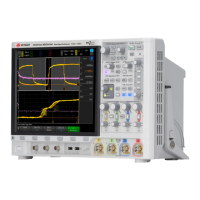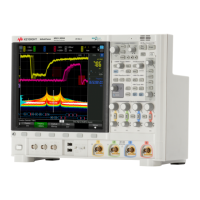:FUNCtion<m> Commands 18
Keysight InfiniiVision 3000T X-Series Oscilloscopes Programmer's Guide 391
• HIGHpass — High pass filter — The FREQuency:HIGHpass command sets the
-3 dB cutoff frequency.
• AVERage — Averaged value — The AVERage:COUNt command specifies the
number of averages.
Unlike acquisition averaging, the math averaging operator can be used to
average the data on a single analog input channel or math function.
If acquisition averaging is also used, the analog input channel data is
averaged and the math function averages it again. You can use both types of
averaging to get a certain number of averages on all waveforms and an
increased number of averages on a particular waveform.
Averages are calculated using a "decaying average" approximation, where:
next_average = current_average + (new_data - current_average)/N
Where N starts at 1 for the first acquisition and increments for each
following acquisition until it reaches the selected number of averages, where
it holds.
• SMOoth — Smoothing — The resulting math waveform is the selected source
with a normalized rectangular (boxcar) FIR filter applied.
The boxcar filter is a moving average of adjacent waveform points, where
the number of adjacent points is specified by the SMOoth:POINts command.
You can choose an odd number of points, from 3 to 999.
The smoothing operator limits the bandwidth of the source waveform. The
smoothing operator can be used, for example, to smooth measurement
trend waveforms.
• ENVelope — Envelope — The resulting math waveform is the amplitude
envelope for an amplitude modulated (AM) input signal.
This function uses a Hilbert transform to get the real (in-phase, I) and
imaginary (quadrature, Q) parts of the input signal and then performs a
square root of the sum of the real and imaginary parts to get the
demodulated amplitude envelope waveform.
Filters operate on a single analog channel source or on a lower math function.
•Visualizations:
• MAGNify — Operates on a single analog channel source or on a lower math
function.
• MAXHold — Operates on a single analog channel source or on a lower math
function. The Max Hold (or Max Envelope) operator records the maximum
vertical values found at each horizontal bucket across multiple analysis
cycles and uses those values to build a waveform.

